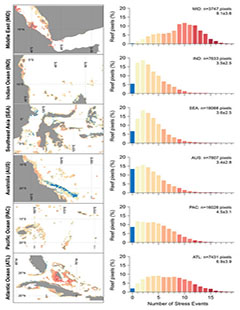-
Home
-
Data & Publications
-
Regional Portals
- About Regional Portals
- Florida
- Navassa Island
- Puerto Rico
- Flower Garden Banks
- U.S. Virgin Islands
- American Samoa
- Commonwealth of the Northern Mariana Islands
- Federated States of Micronesia
- Guam
- Main Hawaiian Islands
- Republic of the Marshall Islands
- Northwestern Hawaiian Islands
- Republic of Palau
- Pacific Remote Island Areas
-
CRCP Activities
- Glossary
Warming Trends and Bleaching Stress of the World's Coral Reefs 1985-2012

Coral reefs across the world are currently being affected by the longest bleaching event on record (from 2014 to at least 2016). As oceans warm, bleaching events are expected to become more common and more severe. Unfortunately, there is a relative dearth of information on how past thermal conditions have affected the compositions of coral reefs and their ability to respond to subsequent stress events. This paper seeks to address this perceived gap in knowledge by analyzing satellite temperature data from 1985-2012 in order to assess and provide ways to understand thermal history trends and patterns for reefs worldwide. This article is freely available in the online journal Nature.
Citation: Heron, S. F. et al. 2016. Warming Trends and Bleaching Stress of the World's Coral Reefs 1985-2012 Scientific Reports 6, 38402; doi: 10.1038/srep38402.
For more information on coral bleaching and related products, visit:
NOAA Coral Reef Watch Satellite Monitoring.


